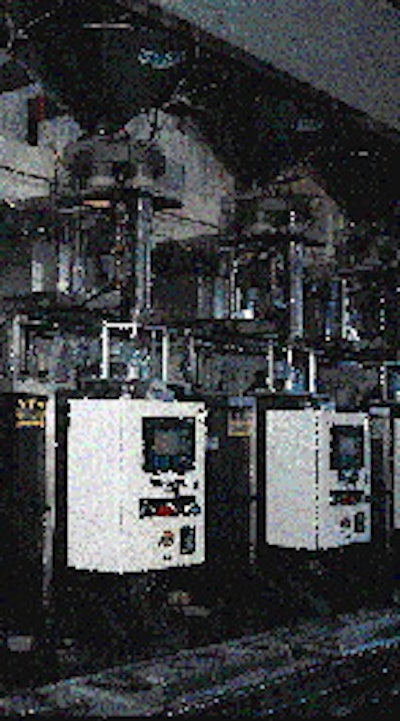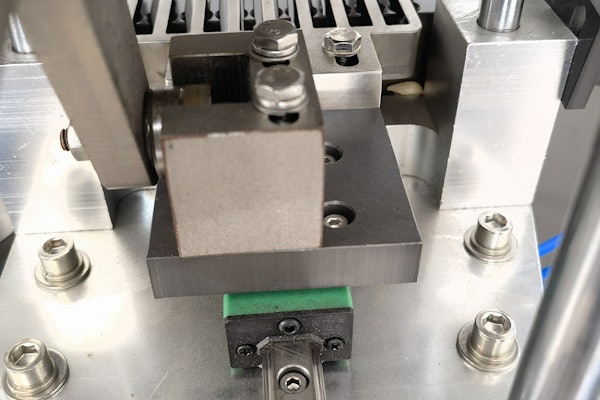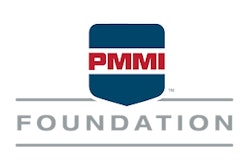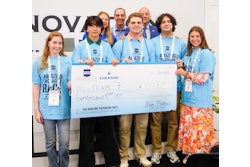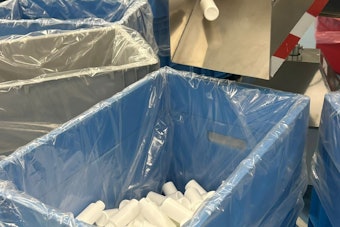Founded in 1987 as a contract grower of cranberries for the Ocean Spray growers' cooperative, Northland Cranberries, now the world's largest cranberry grower, became an independent grower and marketer in 1993. Its first season of branded fresh fruit marketing was 1993, and the market reaction was so favorable that the Wisconsin Rapids, WI, firm underwent a major expansion of its packaging operation in 1995. The heart of the operation: eight automatic bagging systems consisting of volumetric fillers from Spee-Dee Packaging (Sturtevant, WI) and vertical form/fill/seal machines from Gess Systems (Palmyra, WI). Rounding out the packaging equipment setup, which produces 12-oz polyethylene bags of fresh berries sold through supermarkets, are a vibratory feed conveyor system and, near the end of the line, a metal detector from Allen Intl. (Newberg, OR); a second case erector from Marq (Yakima, WA); and an automatic flap folder added to the Durable Packaging (Countryside, IL) case taper installed in 1994. The eight new filler/baggers replaced four similar systems used by Northland for its first two retail fresh fruit packing seasons. Employing essentially the same number of operators as it did in the past, the firm's case output has increased 50%. What makes the nearly half million-dollar investment in packaging equipment unusual is that, due to the seasonal nature of the fresh cranberry business, the equipment sits idle for eight months each year. During September through December, however, it's anything but idle, running 20 hours daily seven days a week. Conveyor-to-hopper delivery Ahead of the packaging equipment are drying and sorting operations. Then berries are delivered to the bagging machines by the Allen vibratory conveyor. Immediately beneath it are all eight hoppers of the Spee-Dee fillers. Inside each hopper are three proximity switches that sense the level of berries. "If the berries in the hopper are below the low level sensor, it signals the bagging machine below it to stop and also signals the overhead gate in the vibratory conveyor to open and let more berries into the hopper," says fresh fruit manager Kevin Lewis. "Once berries are above the low-level sensor, the bagger starts operating. Once berries are above the mid level, a signal is sent to close the gate and cut off the berries. The high level is to detect if some malfunction is causing too many berries to enter the hopper for the bagger to keep up." The way the system is set up, all eight baggers are fed by the same flow of berries, so the baggers at the head of the line get priority. That means occasionally the seventh or eighth one in the line may get starved for product for a period of time, but that doesn't happen very often. The Spee-Dee units are all Model CBE volumetric cup fillers. Though a standard offering from Spee-Dee, these units are a little different in that the sidewalls of the hoppers are less sharply angled than usual. This helps keep the berries from bridging. Right beneath the filler hopper are four cups in a plate assembly that rotates on an intermittent-motion basis. Product drops into a cup that is leveled off by a hopper brush. A cup receives product at 12 o'clock, dumps it at 6 o'clock, then receives another product charge at 12. The cups also telescope so that different-sized fills can be executed. Lined up beneath the Spee-Dee hoppers are the eight vf/f/s machines from Gess Systems. Using side-belt film feeders to draw film over a forming collar, the machines heat seal the film longitudinally, turning the film into a long tube. With each cycle, heat seal jaws close on the tube to form the top of the bag just finished and the bottom of the bag about to be filled. Product is released from the overhead filler and the cycle is repeated. The 1.5-mil low-density polyethylene rollstock, printed flexo in eight colors, is supplied by Banner Packaging (Oshkosh, WI). "The baggers are designed to run at 40 bags per minute," says Lewis. "We usually go 35 per minute, though we have reached 45." Designed for limited space According to Gess Systems' Larry Gess, Northland had a limited amount of floor space available for its new packaging operation. So it asked if his engineers could remove the bulk of the control componentry from each bagger and mount it in cabinets along the wall behind the row of machines. The operator's console is still a part of each bagger, but the PLC controls are not. All eight Allen-Bradley (Milwaukee, WI) SLC-503 microprocessors, and a ninth that controls the overhead vibratory feed conveyor, are mounted in the wall cabinets. They control the proximity switches, air cylinders, servo motors driving side-belt film feeders, and everything else their software commands them to. "Putting the controls along that wall kept the machines themselves more compact and helped us keep the machines closer together," says Gess. "Otherwise they might have been on eight-foot centers instead of four-foot." Indeed, the eight baggers are arranged so snugly they almost give the appearance of a single eight-headed unit as opposed to eight separate systems. All eight baggers discharge their 12-oz packages onto the same conveyor, which takes its load to a manual case loading conveyor fed by two automatic case erectors supplied by Marq. Integrated into each Marq unit is an SLC-501 programmable logic controller from Allen-Bradley. "We want the case accumulation conveyor to send a signal back to the case erectors when the conveyor is full so no more cases will be made," says Lewis in explaining why the PLC was included. "Allen-Bradley provided the programming base software and a local company did the ladder logic programming for us. The other thing the PLC lets us do is have the two case erectors time their motions to deliver cases smoothly into the same case accumulation conveyor." The 44 ECT C-flute shippers have an outer liner of mottled white that's printed flexo in two colors. Great Lakes Packaging (Germantown, WI) supplies the custom case with an integral divider down the center. After cases are loaded manually with 24 bags each, they're conveyed through the metal detector and then to the Durable case taper. Finished cases are palletized manually and taken to the warehouse/ distribution area. The 50% increase in case output that Northland gained with the new baggers means a lot to its marketing efforts. "The gain in capacity lets us meet the key seasonal demands of our customers," says vice president of sales and marketing Robert Hawk. "It's particularly important in the three weeks prior to the U.S. Thanksgiving, traditionally the peak period for fresh cranberries."
